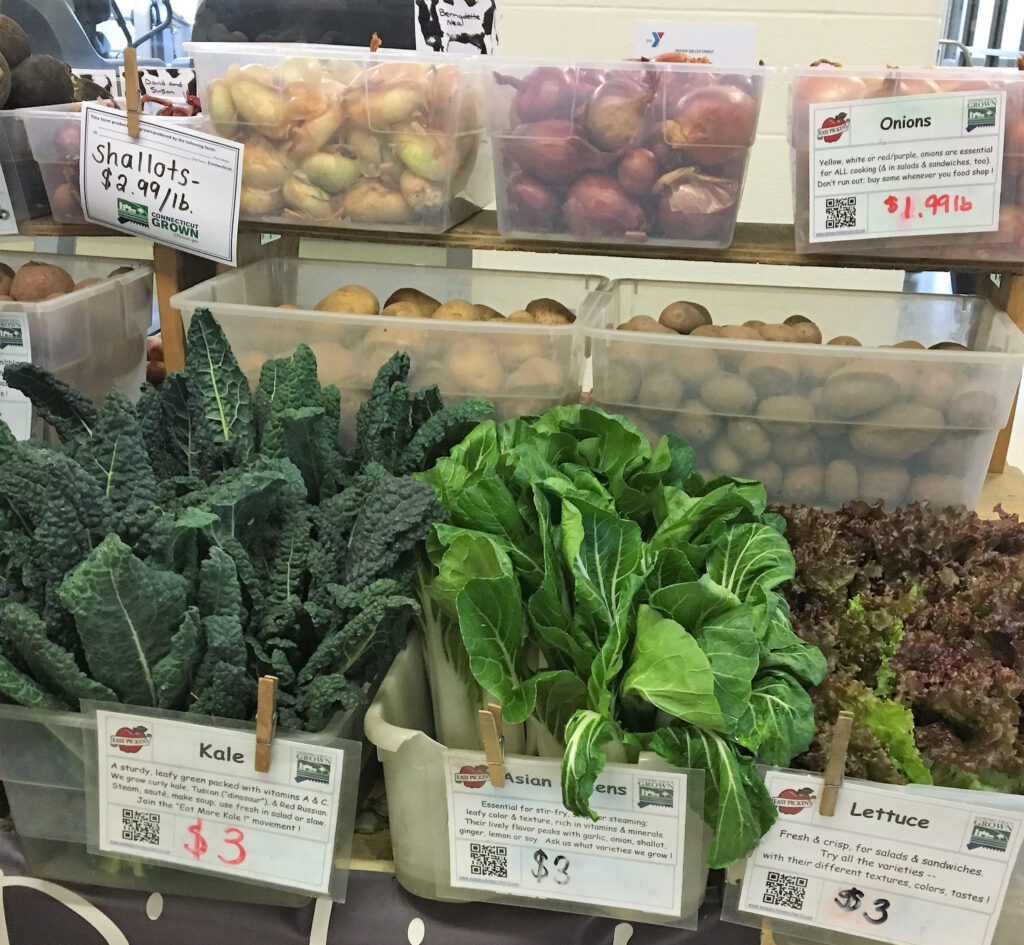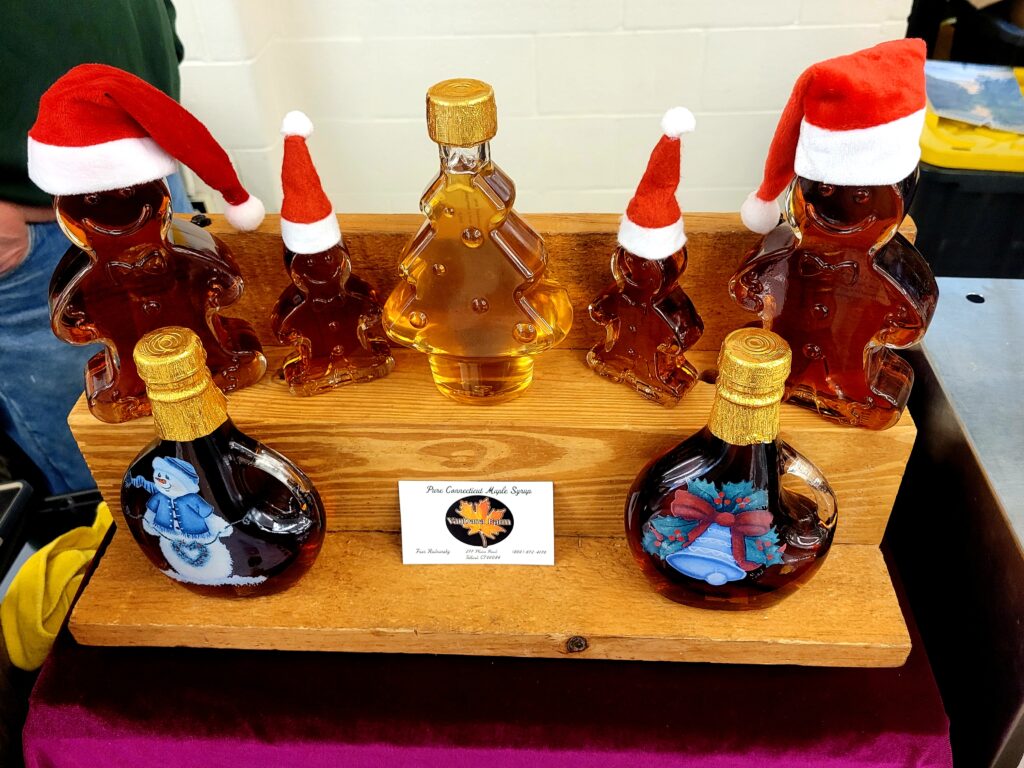
New Englanders are a hardy people, often stubbornly so. When cold weather arrives, we see no reason to give up the activities we’ve enjoyed in the summer and autumn. We may put on an extra layer or two, but we’ll still visit the beach, fire up the grill, or even head out on a bike ride.
So it shouldn’t come as a surprise that we like to keep our farmers’ markets running in the winter as well, even if we do move them inside. While these occasions may look a little different from the collection of tents and vendors that pop up in parks and other green spaces during the summer, they support the same mission of providing a community gathering place to find fresh food and meet your CT Grown farmers.
“Our farmers are using innovative techniques to extend the growing season and offer fresh produce and other CT Grown products well into the winter,” said Erin Windham, Agriculture Marketing & Inspection Representative 2 at the Connecticut Department of Agriculture. “Winter farmers’ markets not only offer an extended market for producers, but are also a great place to connect with people during the drearier months of the year and find unique holiday gifts for your loved ones.”
Is there really fresh CT Grown produce available during the winter?
Yes! The selection of fruits and vegetables will differ from what you find in the summer, but Connecticut farmers are still harvesting even after the frosts begin to arrive.
Traditionally, farmers have used greenhouses to extend growing seasons. These structures maintain warm temperatures and allow for the control of other growing conditions, such as irrigation. Greenhouses permit the year-round cultivation of summer crops like tomatoes and cucumbers, so you can still find fresh fruits and veggies — even when it’s snowing.
High tunnels, a greenhouse alternative, are also increasing in popularity in Connecticut. Consisting of a frame and plastic sheeting, these structures cover crops grown in the ground or in raised beds, protecting them from the cold or severe weather. High tunnels are simpler and less expensive than greenhouses, and allow farmers to keep harvesting crops into the winter.
Hydroponic and aquaponic systems have also allowed farmers to grow fresh produce year-round in Connecticut. Hydroponic systems allow plants to grow in a water-based, nutrient-rich medium rather than soil; they also permit farmers to adjust the necessary balance of water, nutrients, and oxygen, allowing crops to be grown quickly and efficiently. An aquaponic system combines hydroponics with aquaculture, allowing farmers to raise aquatic animals like fish whose nitrogen-rich waste provides nutrients to plants.
Some late season fruits and vegetables do well in cold storage, making them more readily available at winter markets. These crops include apples, beets, onions, potatoes, and turnips.
Certain vegetables have strong root systems, which mean they can remain in the ground over the winter and be harvested during this season. Cabbage, carrots, parsnips, and rutabaga are some of the crops that are still available late into the season due to this overwintering method.
Mushrooms are grown indoors, so they aren’t dependent on weather conditions and can be found fresh year-round. Some crops’ extended growing seasons also permit year-round availability, including herbs, lettuce, kale, and radishes.

Besides produce, what else can I buy at a winter farmers’ market?
Winter is the time for CT Grown products with year-round availability to shine at farmers’ markets. Our dairy farms stay busy over the winter, producing milk, cheese, cream, yogurt, and ice cream. Animal products like meats, eggs, fish, and shellfish are also available.
While we don’t often think of meats as having seasons like fruits and vegetables, you may notice expanded availability as producers work to ensure that specialities such as beef, pork, and lamb roasts, along with turkey, goose, and duck breast are ready for your holiday meals. This is also a great time of year to stock up on meat products for hearty soups, stews, and chili to feed a crowd and keep you warm.
Farmers who prepare for winter markets in advance will set aside some of their harvest for pickling or preserving, creating products like relishes, salsa, jams, and jellies. Other value-added products brought to market in the winter include honey, cider, maple products, beer, wine, and spirits.
You’ll see an increased focus on prepared foods at winter farmers’ markets with vendors selling baked goods and ready-to-eat soups and meals. You can also find handmade artisan items like soaps, candles, wood products, and clothing made from locally raised sheep and alpaca.


How do winter farmers’ markets support Connecticut farmers?
Farm revenue is often cyclical, with many farmers collecting the bulk of their income during harvest season. By selling products at winter markets, farmers can maintain cash flow during slower periods.
Winter markets help prevent food waste and lost income due to bruised or unsold fruits and vegetables. Instead of throwing this produce out, farmers can use it for preserves, sauces, and other value-added products to be sold later in the year.
Some farmers use the winter to take a breather from the busy season, which naturally means that winter markets are smaller than summer markets. Farmers who want to stay busy during the season can use winter markets to maintain a connection with their customers, enjoying face-to-face interactions throughout the year.
Can I use food benefits at a winter farmers’ market?
Benefits under the Farmers’ Market Nutrition Program (FMNP) expire on Nov. 30, but many winter markets accept Supplemental Nutrition Assistance Program (SNAP) benefits.
Under recently announced changes, SNAP benefits will go farther to help enrollees purchase local food options. The update to the program increased the number of eligible enrollees and boosted current enrollees’ benefits by 12 percent. Monthly benefits vary based on household size and income, but the change increased single recipients’ benefits by $31 a month and maximum benefits by $104 a month.
Enrollees can visit winter markets during the chillier months to maintain access to fresh produce and other CT Grown products. Some markets will also double benefits for certain products, usually fruit and vegetables.
Where can I find a winter farmers’ market in Connecticut?
Winter markets are sometimes held as one-day occasions to support holiday bazaars or other events, but usually take place weekly or biweekly. Just like their summer counterparts, they can be accompanied by live music, cooking demonstrations, educational workshops, and other entertainment.
July 30, 2022 @ 9:00 AM – 12:30 PM
Accepts SFNMP